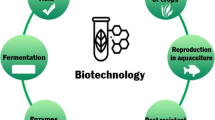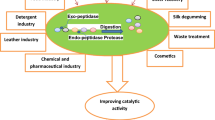Abstract
Feruloyl esterases have potential uses over a broad range of applications in the agri-food industries. In recent years, the number of microbial feruloyl esterase activities reported has increased and, in parallel, even more related protein sequences may be discerned in the growing genome databases. Based on substrate utilisation data and supported by primary sequence identity, four sub-classes have been characterised and termed type-A, B, C and D. The proposed sub-classification scheme is discussed in terms of the evolutionary relationships existing between carbohydrate esterases.

Similar content being viewed by others
References
Andreasen MF, Kroon P, Williamson G, Garcia-Conesa MT (2001) Esterase activity able to hydrolyze dietary antioxidant hydroxycinnamates is distributed along the intestine of mammals. J Agric Food Chem 49:5679–5684
Bartolome B, Faulds CB, Kroon PA, Waldron K, Gilbert HJ, Hazlewood G, Williamson G (1997) An Aspergillus niger esterase (ferulic acid esterase III) and a recombinant Pseudomonas fluorescens subsp. cellulosa esterase (XylD) release a 5-5′-ferulic dehydrodimer (diferulic acid) from barley and wheat cell walls. Appl Environ Microbiol 63:208–212
Basaran P, Hang YD (2000) Purification and characterization of acetyl esterase from Candida guilliermondii. Lett Appl Microbiol 30:167–171
Blum DL, Li XL, Chen H, Ljungdahl LG (1999) Characterization of an acetyl xylan esterase from the anaerobic fungus Orpinomyces sp. strain PC-2. Appl Environ Microbiol 65:3990–3995
Blum DL, Kataeva IA, Li XL, Ljungdahl LG (2000) Feruloyl esterase activity of the Clostridium thermocellum cellulosome can be attributed to previously unknown domains of XynY and XynZ. J Bacteriol 182:1346–1351
Borneman WS, Ljungdahl LG, Hartley RD, Akin DE (1992) Purification and partial characterization of two feruloyl esterases from the anaerobic fungus Neocallimastix strain MC-2. Appl Environ Microbiol 58:3762–3766
Castanares A, McCrae SI, Wood TM (1992) Purification and properties of a feruloyl/p-coumaroyl esterase from the fungus Penicillium pinophilum. Enzyme Microb Technol 14:875–884
Coutinho PM, Henrissat B (1999) Carbohydrate-active enzymes: an integrated database approach. In: Gilbert HJ, Davies GJ, Svensson B, Henrissat B (eds), Recent advances in carbohydrate engineering. Royal Society of Chemistry, Cambridge, pp 3–12
Crepin VF, Faulds CB, Connerton IF (2003a) A non-modular type-B feruloyl esterase from Neurospora crassa exhibits concentration dependent substrate inhibition. Biochem J 370:417–427
Crepin VF, Faulds CB, Connerton IF (2003b) Production and characterisation of the Talaromyces stipitatus feruloyl esterase FAEC in Pichia pastoris: identification of the nucleophilic serine. Protein Express Purif 29:176–184
Dalrymple BP, Swadling Y, Cybinski DH, Xue GP (1996) Cloning of a gene encoding cinnamoyl ester hydrolase from the ruminal bacterium Butyrivibrio fibrisolvens E14 by a novel method. FEMS Microbiol Lett 143:115–120
De Vries RP, Visser J (1999) Regulation of the feruloyl esterase (faeA) gene from Aspergillus niger. Appl Environ Microbiol 65:5500–5503
De Vries RP, Visser J (2001) Aspergillus enzymes involved in degradation of plant cell wall polysaccharides. Microbiol Mol Biol Rev 65:497–522
De Vries RP, Michelsen B, Poulsen CH, Kroon PA, Heuvel RH van den, Faulds CB, Williamson G, Hombergh JP van den, Visser J (1997) The faeA genes from Aspergillus niger and Aspergillus tubingensis encode ferulic acid esterases involved in degradation of complex cell wall polysaccharides. Appl Environ Microbiol 63:4638–4644
De Vries RP, Visser J, Graaff LH de (1999) CreA modulates the XlnR-induced expression on xylose of Aspergillus niger genes involved in xylan degradation. Res Microbiol 150:281–285
De Vries RP, Jansen J, Aguilar G, Parenicova l, Joosten V, Wulfert F, Benen JAE, Visser J (2002a) Expression profiling of pectinolytic genes from Aspergillus niger. FEBS Lett 530:41–47
De Vries RP, Kuyk PA van, Kester HC, Visser J (2002b) The Aspergillus niger faeB gene encodes a second feruloyl esterase involved in pectin and xylan degradation and is specifically induced in the presence of aromatic compounds. Biochem J 363:377–386
Degrassi G, Kojic M, Ljubijankic G, Venturi V (2000) The acetyl xylan esterase of Bacillus pumilus belongs to a family of esterases with broad substrate specificity. Microbiology 146:1585–1591
Donaghy JA, Bronnenmeier K, Soto-Kelly PF, McKay AM (2000) Purification and characterization of an extracellular feruloyl esterase from the thermophilic anaerobe Clostridium stercorarium. J Appl Microbiol 88:458–466
Dowzer CEA, Kelly JM (1991) Analysis of the creA gene, a regulator of carbon catabolite repression in Aspergillus nidulans. Mol Cell Biol 11:5701–5709
Ebbole DJ (1998) Carbon catabolic repression of gene expression and conidiation in Neurospora crassa. Fungal Genet Biol 25:15–21
Faulds CB, Williamson G (1991) The purification and characterization of 4-hydroxy-3-methoxycinnamic (ferulic) acid esterase from Streptomyces olivochromogenes. J Gen Microbiol 137:2339–2345
Faulds CB, Williamson G (1994) Purification and characterization of a ferulic acid esterase (FAE-III) from Aspergillus niger: Specificity for the phenolic moiety and binding to microcrystalline cellulose. Microbiology 140:779–787
Faulds CB, Williamson G (1995) Release of ferulic acid from wheat bran by a ferulic acid esterase (FAE-III) from Aspergillus niger. Appl Microbiol Biotechnol 43:1082–1087
Faulds CB, Williamson G (1999) Effect of hydroxycinnamates and benzoates on the production of feruloyl esterases by Aspergillus niger. J Sci Food Agric 79:450–452
Faulds CB, De Vries RP, Kroon PA, Visser J, Williamson G (1997) Influence of ferulic acid on the production of feruloyl esterases by Aspergillus niger. FEMS Microbiol Lett 157:239–244
Ferreira LMA, Wood TM, Williamson G, Faulds C, Hazlewood GP, Black GW, Gilbert HJ (1993) A modular esterase from Pseudomonas fluorescens subsp. cellulosa contains a non-catalytic cellulose-binding domain. Biochem J 294:349–355
Fillingham IJ, Kroon PA, Williamson G, Gilbert HJ, Hazlewood GP (1999) A modular cinnamoyl ester hydrolase from the anaerobic fungus Piromyces equi acts synergistically with xylanase and is part of a multiprotein cellulose-binding cellulase-hemicellulase complex. Biochem J 343:215–224
Gutierrez R, Cederlund E, Hjelmqvist L, Peirano A, Herrera F, Ghosh D, Duax W, Jornvall H, Eyzaguirre J (1998) Acetyl xylan esterase II from Penicillium purpurogenum is similar to an esterase from Trichoderma reesei but lacks a cellulose binding domain. FEBS Lett 423:35–38
Henikoff S, Henikoff J (1992) Amino acid substitution matrices from protein blocks. Proc Natl Acad Sci USA 89:10915–10919
Kroon PA, Williamson G (1996) Release of ferulic acid from sugar-beet pulp by using arabinanase, arabinofuranosidase and an esterase from Aspergillus niger. Biotechnol Appl Biochem 23:263–267
Kroon PA, Faulds CB, Williamson G (1996) Purification and characterization of a novel esterase induced by growth of Aspergillus niger on sugar-beet pulp. Biotechnol Appl Biochem 23:255–262
Kroon PA, Faulds CB, Brezillon C, Williamson G (1997) Methyl phenylalkanoates as substrates to probe the active site of esterases. Eur J Biochem 248:245–251
Kroon PA, Garcia-Conesa MT, Fillingham IJ, Hazlewood GP, Williamson G (1999) Release of ferulic acid dehydrodimers from plant cell walls by feruloyl esterases. J Sci Food Agric 79:428–434
Kroon PA, Williamson G, Fish NM, Archer DB, Belshaw NJ (2000) A modular esterase from Penicillium funiculosum which releases ferulic acid from plant cell walls and binds crystalline cellulose contains a carbohydrate binding module. Eur J Biochem 267:6740–6752
Linden J, Samara M, Decker S, Johnson E, Boyer M, Pecs M, Adney W, Himmel M (1994) Purification and characterization of an acetyl esterase from Aspergillus niger. Appl Biochem Biotechnol 383:45–46
McCrae SI, Leith KM, Gordon AH, Wood TM (1994) Xylan-degrading enzyme system produced by the fungus Aspergillus awamori: isolation and characterization of a feruloyl esterase and a p-coumaroyl esterase. Enzyme Microb Technol 16:826–834
McDermid KP, Forsberg CW, MacKenzie CR (1990) Purification and properties of an acetyl xylan esterase from Fibrobacter succinogenes S85. Appl Environ Microbiol 56:3805–3810
Orejas M, MacCabe AP, Perez-Gonzalez JA, Kumar S, Ramon D (2001) The wide-domain carbon catabolite repressor CreA indirectly controls expression of the Aspergillus nidulans xlnB gene, encoding the acidic endo-β-(1,4)-xylanase X24. J Bacteriol 183:1517–1523
Peij NNME van, Visser J, Graaff LH de (1998) Isolation and analysis of xlnR, encoding a transcriptional activator co-ordinating xylanolytic expression in Aspergillus niger. Microbiology 27:131–142
Prates JAM, Tarbouriech N, Charnock SJ, Fontes CMGA, Ferreira LMA, Davies GJ (2001) The structure of the feruloyl esterase module of xylanase 10B from Clostridium thermocellum provides insights into substrate recognition. Structure 9:1183–1190
Ralet MC, Faulds CB, Williamson G, Thibault, JF (1994) Degradation of feruloylated oligosaccharides from sugar-beet pulp and wheat bran by ferulic acid esterases from Aspergillus niger. Carbohydr Res 263:257–269
Ruijter GJG, Visser J (1997) Carbon repression in Aspergilli. FEMS Microbiol Lett 151:103–114
Saitou N, Nei M (1987) The neighbor-joining method: a new method for reconstructing phylogenetic trees. Mol Biol Evol 4:406–425
Sancho AI, Faulds CB, Bartolomé B, Williamson G (1999) Characterisation of feruloyl esterase activity in barley. J Sci Food Agric 79:447–449
Schubot FD, Kataeva IA, Blum DL, Shah AC, Ljungdahl LG, Rose JP, Wang BC (2001) Structural basis for the substrate specificity of the feruloyl esterase domain of the cellulosomal xylanase Z from Clostridium thermocellum. Biochemistry 40:12524–12532
Shoham Y, Lamed R, Bayer EA (1999) The cellulosome concept as an efficient microbial strategy for the degradation of insoluble polysaccharides. Trends Microbiol 7:275–281
Strauss J, Mach RL, Zeilinger S, Hartler G, Stoffler G, Wolschek M, Kubicek CP (1995) Cre1, the carbon catabolic repressor protein from Trichoderma reesei. FEBS Lett 376:103–107
Tenkanen M, Schuseil J, Puls J, Poutanen K (1991) Production, purification and characterization of an esterase liberating phenolic-acids from lignocellulosics. J Biotechnol 18:69–84
Thompson JD, Higgins DG, Gibson TJ (1994) CLUSTAL W: improving the sensitivity of progressive multiple sequence alignment through sequence weighting, position-specific gap penalties and weight matrix choice. Nucleic Acids Res 22:4673–4680
Williamson G, Faulds CB, Kroon PA (1998a) Specificity of ferulic acid (feruloyl) esterases. Biochem Soc Trans 26:205–209
Williamson G, Kroon PA, Faulds CB (1998b) Hairy plant polysaccharides: a close shave with microbial esterases. Microbiology 144:2011–2023
Acknowledgements
We would like to thank the Biotechnology and Biological Sciences Research Council (BBSRC), UK, and the Department of Trade and Industry, UK, for their support through the LINK Applied Biocatalysts programme (Grant number BTL/27/12).
Author information
Authors and Affiliations
Corresponding author
Rights and permissions
About this article
Cite this article
Crepin, V.F., Faulds, C.B. & Connerton, I.F. Functional classification of the microbial feruloyl esterases. Appl Microbiol Biotechnol 63, 647–652 (2004). https://doi.org/10.1007/s00253-003-1476-3
Received:
Revised:
Accepted:
Published:
Issue Date:
DOI: https://doi.org/10.1007/s00253-003-1476-3




